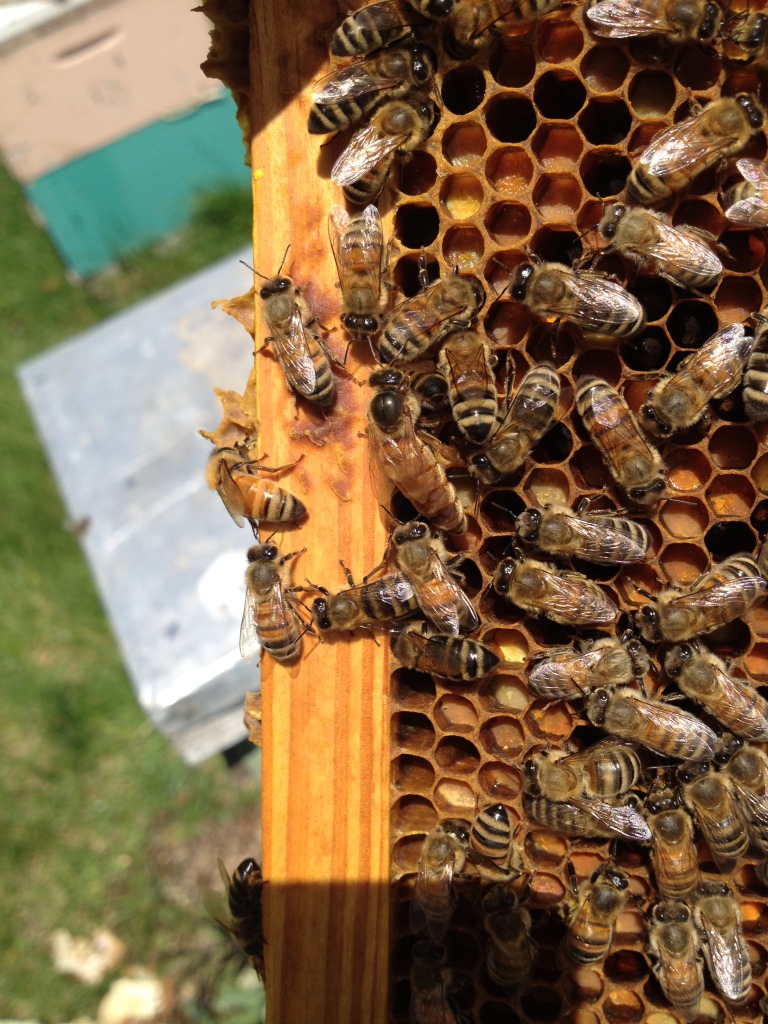Tagged: grafting
queen-rearing field demo … tomorrow
Hi All.
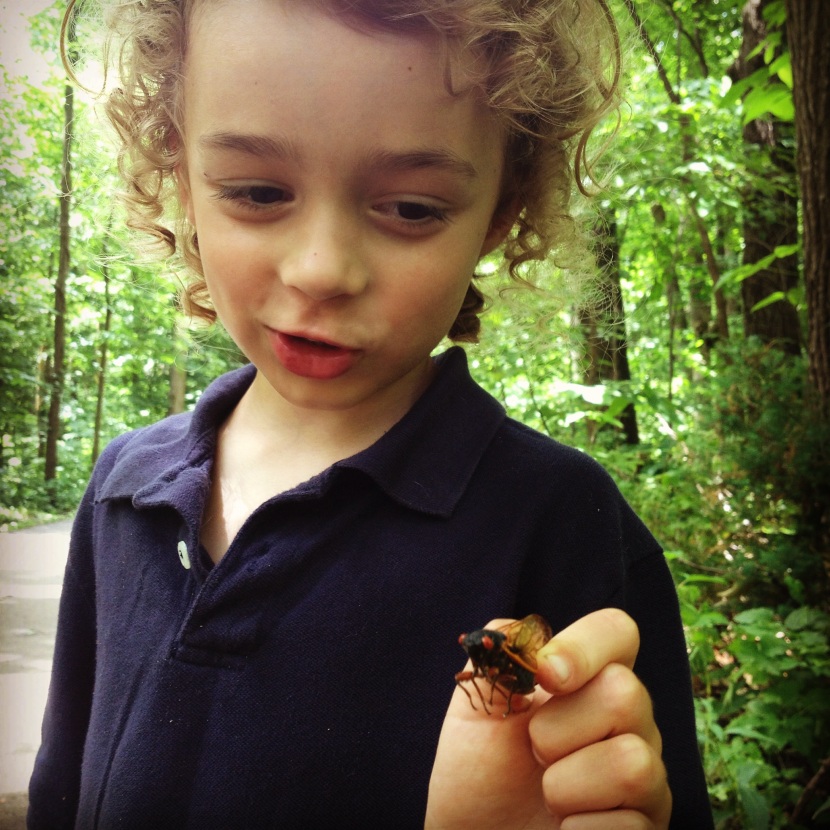
The cicadas are still at it. Good reason to get outside.
First off, for those of you relatively nearby: I plan to hold an informal field day tomorrow to demonstrate a bit on queen rearing. I have a cell-builder hive all set to go. We’ll talk about what characteristics I select for when choosing a breeder colony. We’ll pull a frame of proper-aged larvae and do a bit of grafting sitting on my tailgate. There are several ways to make queens on a small-scale (20 to 50 or so queens at a time); this is just how I’m doing it. It works. There are several good books on the subject. Check out Larry Connor’s Wicwas Press website for some of my favorites: http://www.wicwas.com . And this video is as good as they get: https://www.youtube.com/watch?v=R7tinVIuBJ8 Micheal Palmer has become something of a cult figure in northern beekeeping for his “sustainable” approach. He emphasizes the importance of getting off the treadmill of package colonies & commercially-produced queens from areas & operations dissimilar to what you have going on with your own bees. …For what it’s worth, I couldn’t agree more. Anyway, we’ll be meeting up in my yard adjacent to the Chichaqua Bottoms Greenbelt in Maxwell, IA tomorrow (June 26th) at 1:00. Contact me if you’re interested and need directions to get there.
Happy belated Father’s Day. I figure since this blog is being read now by at least 8 or 10 people, it’s possible I’m reaching at least 3 to 5 fathers out there.
Thanks to my family for the perfect gifts!:

and

We have more bee food out there now:

Basswood is still going around here.

I love to see the (butterfly) milkweed come on. …wish there was a whole lot more of it.
Also just starting to see some white sweet clover flowering. Seems very early. This can be huge if it’s gets hot and stays hot. Don’t yet have a good photo of it to share.
This spring has been so easy going for the bees. Once they found the end of winter, the spring buildup couldn’t have been more smooth. This has been reflected in their health. Decent temperatures, few days of rain (til recently), and plenty of consistent bloom have all played into proper nutrition and low stresses for them. Newly started colonies have expanded well and many now are collecting surplus honey already. Wintered colonies have become strong, been split (maybe more than once), and have already produced good amounts of surplus for us. Some areas of Iowa have had a bit too much rain in the last week or two, and I’m sure this has affected bees in those parts, but overall … wow. Last season, there was so much sickness – much of it related to poor seasonal conditions reducing foraging, building colony stresses, and compromising nutrition. European foul brood (typically a more minor bacterial brood disease) was everywhere. This year, disease has been minimal. Everyone’s bees are looking great.
I found some unfortunate exceptions to this yesterday, and wanted to share some photos. Lots of beekeepers pull out cell phone cameras and take pics of prize winning “wood to wood” perfect frames of brood when we pull them from our hives. It’s harder to snap photos when things aren’t so ideal. This condition was found across a yard of about 20 or 21 colonies yesterday in northern Story County:

This first frame shows a pretty serious chalk brood problem. Chalkbrood is a fungal infection. It’s generally pretty common in low levels in wetter springs as the temperature starts to climb, especially in apiaries with tall grasses and weeds blocking hive entrances choking off ventilation, and in apiaries located in low lying areas where morning fogs might linger. As the fungus digests the larvae, it becomes hard and “chalky” typically white in color though sometimes grey to black (fruiting bodies, I’m told). The “mummies” are loose in the cells. The adult bees throw the mummies out in front of the hive as they try to clean out the frames. Sometimes you’ll find the mummies piled at the entrance or on the ground in front of the hive.
There’s another infection in there, better seen in these next two photos:


In these, you’ll note the same shotty brood pattern, with more open cells than capped pupae. You see some chalkbrood, but there are a lot of orangey brown larvae sort of “melting” in their cells. I believe these are succumbing to European Foulbrood, or EFB, a bacterial infection. The larvae, normally fat and glistening white, turn and stretch lengthwise in their cells. Many begin to look like tiny mandarin orange slices as their body becomes orange highlighted by the white tracheal breathing tubes striping their sides. As they’re not being well-cared for by the few workers in these hives, they begin to dry out and shrink and become brownish. If you “twizzle” them with a small dry twig, they’re not at all ropey or gooey (as in AFB cases). I could just barely pick up a spoiled, sour milk, lactic acid sort of smell yesterday. Despite the considerable size of my nose, I’m not very good at smelling things… Sometimes though, the odor can be pretty strong.
These colonies were very weak, though some were faring better than others. They appeared to be splits made relatively recently. I think the main problem is an imbalance – too much brood to be tended to by way too few worker bees. Probably the real problem is just the weakness of the colonies in the first place. The larvae aren’t being properly fed and cared for by the nurses. Under stress, the infections are moving in on a “secondary” sort of level, but left untreated these problems could quickly take the colonies down. They are all queenright, but the queens’ best egg-laying efforts are being matched by the brood succumbing to the infections and dying. As the workers struggle to clean up the dead larvae, they spread the disease further, and new brood becomes exposed as it reaches a susceptible age. There’s no registered product for treatment of chalkbrood, but there are a couple antibiotics available for control of the bacterial infection. There weren’t enough adults in the hives for me to be comfortable with sacrificing some for Varroa samples. Sometimes with high mite populations, you’ll find very similar symptoms (often referred to as parasitic mite syndrome, or PMS). I didn’t completely rule that out here, but I don’t believe mites were a main causal factor for these. I’d guess the parent colonies these splits came from were properly treated for Varroa earlier this spring.
And abruptly switching topics to end on a more pleasant note, here’s some rattlesnake master getting pretty close:
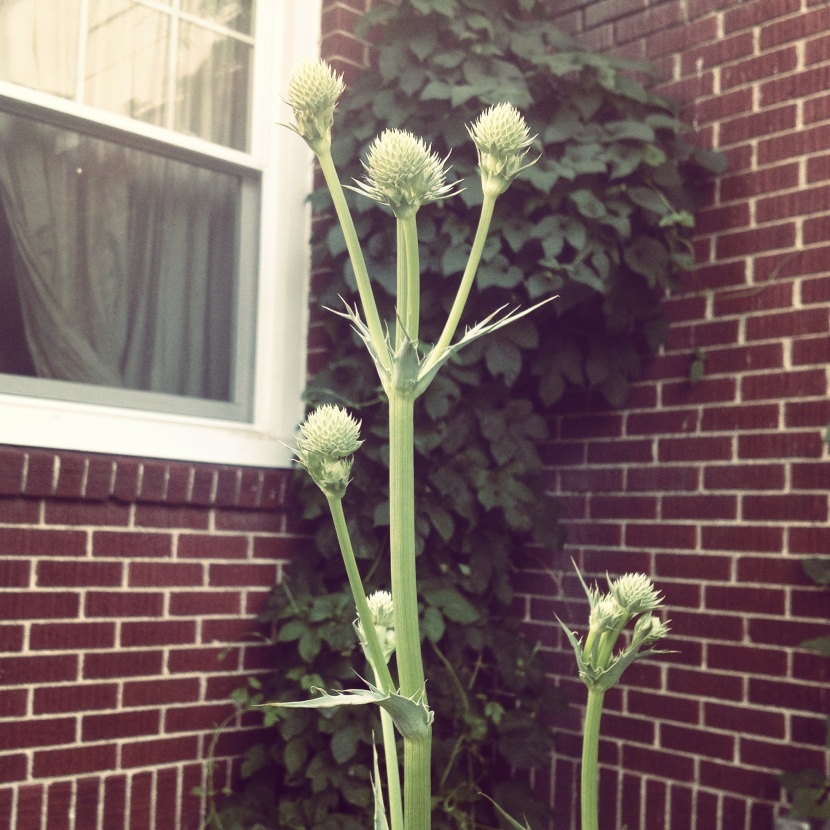
Very cool plant. One of my favorites. We don’t tend to focus much on the prairie natives in terms of a honey crop but it all adds up. Native plants are important to all sorts of pollinators here and it’d be great to see more of them incorporated back into our landscape.
See you.
Happy Mother’s Day.

Happy Mother’s Day dear reader(s?).

Picking up where I left off last time: a pimp cup of Peace Tree’s Red Rambler to “celebrate” the first round of grafts of the season. Something happened to the bottom bar of ten cells … none of them took. Maybe it sat for too long between being grafted and being placed in the hive. They were covered with a damp paper towel while I worked through the other 20 grafts. Maybe it was too cold of an evening that first night and the bees clustered above it. There are a ton of bees in there, but who knows? Whatever the reason, the nurse bees just ignored it. Of the other two bars of grafted larvae, I had a 19 out of 20 acceptance.

So 19 out of 30 grafts are looking really good. This picture was taken maybe 18 or 20 hours after they were started: just old enough to be able to easily tell which cells are being cared for vs. which are being neglected. A quick check yesterday evening showed the queen cells are nice & long which means they’ve been provided lots of royal jelly and are being well cared for. In a day or two, I need to get the mating nucs assembled and in place. Time flies.
Rambling on about queens, note the tiny tragedy above. See the Varroa mite hitching a ride on that nice looking queen? Alex Ebert mentioned to me once maybe a year or so ago that he’d snapped a photo of the same thing. He takes some of the best honey bee photos I’ve ever seen, by the way. I found this one in an inspection in Ankeny. The mite may just be using the queen as quick & easy transportation, but even so … it’s just wrong. Tis the season to absolutely blast those things.

Tis also the season for these things.
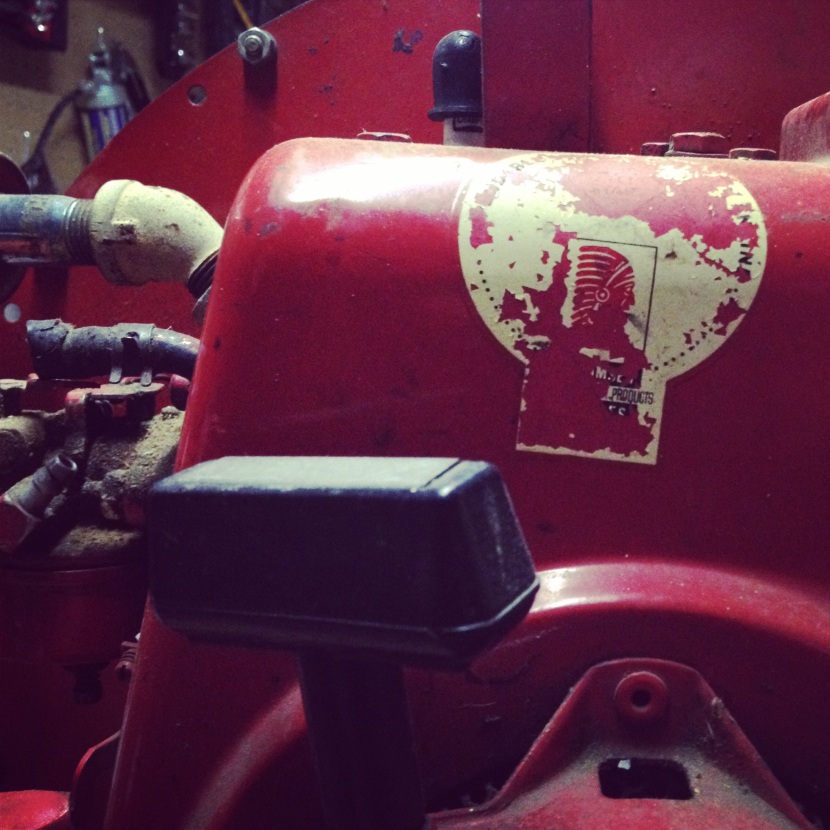
Started the day early with a pot of coffee in the garage going over this beast. I have a weird sort of nostalgia for old Tecumseh engines. I think my Dad’s Dad had a thing for them – to be honest, I’m not sure. In any case, there’s a bit of a family resemblance to the old logo. Glen Stanley gave me this bee blower maybe five years ago already. Safe to say it’s had a few decades of use, and it’s still going strong. I’ve taken care of it, but it needs a little attention here over the next couple months.
And spent the afternoon at a field day at Sheila & Jerry Weldon’s in Knoxville. They have a beautiful place. Great looking gardens, all sorts of fruit trees, and 16 or 20 colonies of bees. Very nice of them to let us pick through them.
Gratuitous Brood Porn:
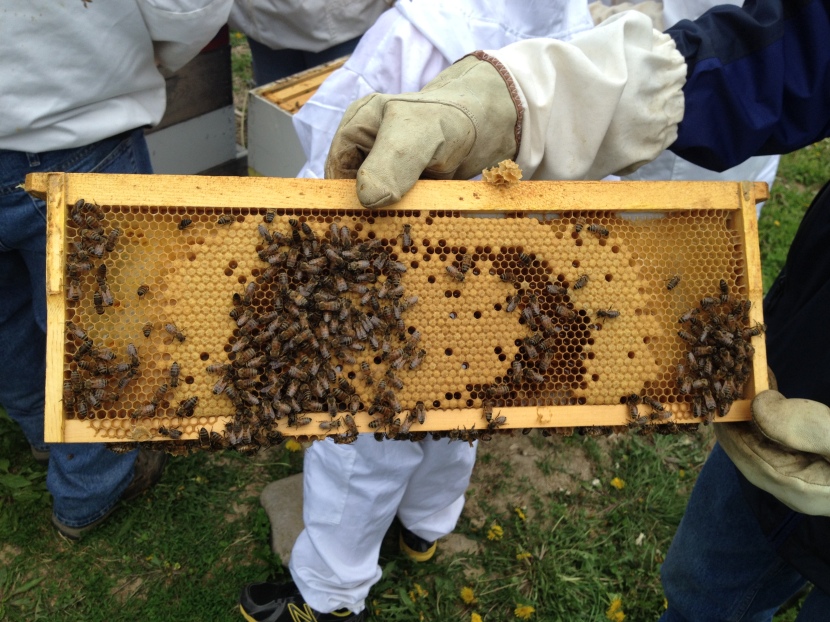
Doesn’t get any better than this one.
Alright. See you. I swear I feel ticks crawling on me. More to come. Thanks for reading.
getting going.
We’ve had a nice couple weeks around here since last time I sat down to write something. Been running around a lot — mostly talking, not actually getting to do too much bee work … yet. I’m ready to go, as might be evidenced by this travel kit:

Note the four most essential components: antacids, headache pills, iodine, and extra lighters.
A neat experience of last week was getting to work with some people from the local Izaak Walton League. They been working with some 4Hers to host some beekeeping educational sessions and establish a couple colonies back behind the range. Some tornado watches in the area kept some people from venturing out to the first bee class (which was fortunately indoors), but the hives are now up and going. Thanks to Vern Ramsey for donating one of the nucs and to Curt & Connie Bronnenberg for the two queens. Here’s a couple photos taken by Jen Anhalt of the installation on a cold and windy day.
Unrelatedly, Science!
Had the task of collecting a few bees for the greater good.
These bees will be used somehow by the IDALS Lab folks in equipment calibration or a control or a baseline or who-knows-what as part of the upcoming season’s pesticide residue analysis work.
I hope they like their new home:

Meanwhile, my hives are building up pretty well. There’s a lot of pollen coming in, which does wonders for the bees’ general positive mental attitude. And mine, I guess.

And, finally, it’s time to make some queens. Yesterday I made up a strong cell starter colony. Here’s their hive … a little different from the typical but it works well. The temperature is a little cooler than what I’d like for this, but not too bad. I loaded them up with an extra pound or so of bees to overcompensate.
Two halfway full division board feeders, pollen frames, frames of capped brood, and a pollen sub patty. Not shown in the photo is the frame of cell bars.
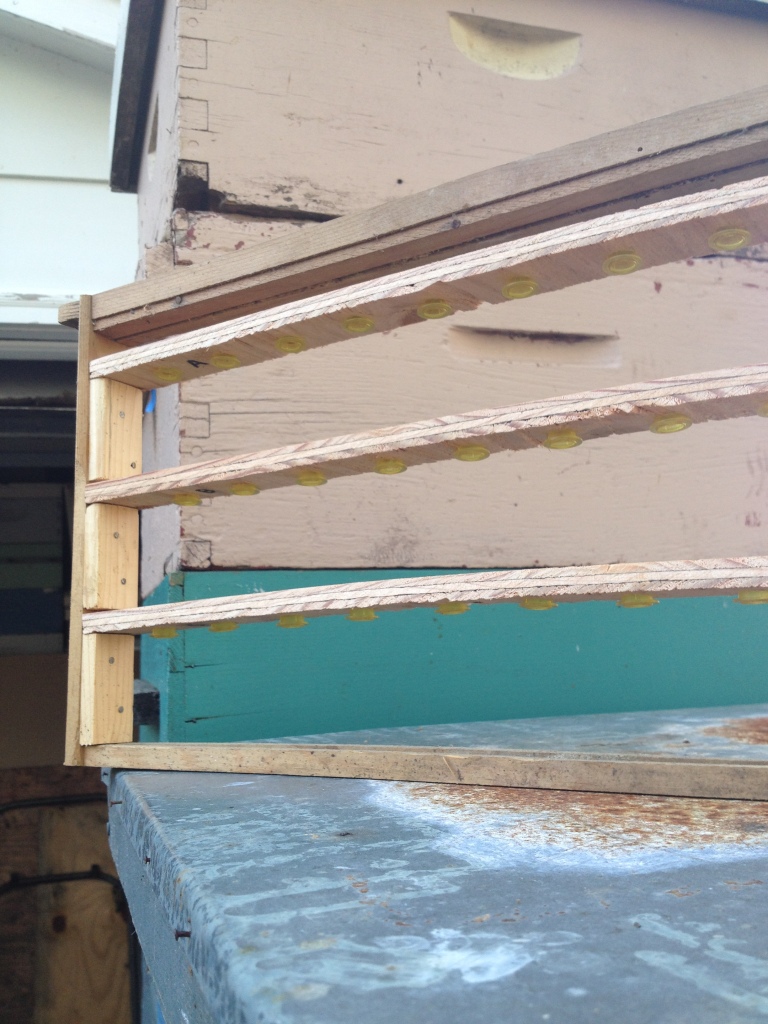
It’s in there now being “polished” by the bees. Here this evening, I’ll graft 30 tiny larvae into the cups, and cross some fingers. Please stay tuned.











